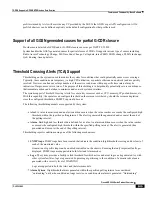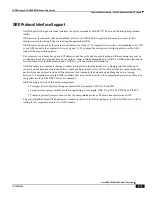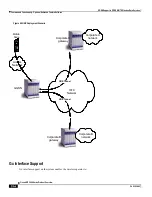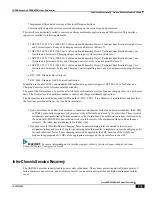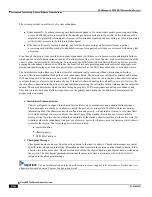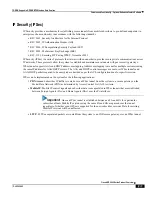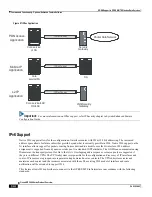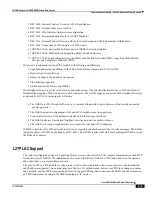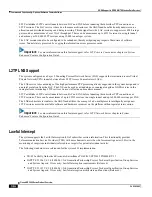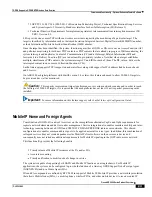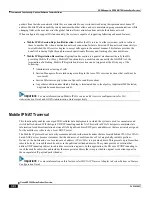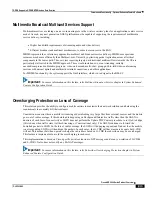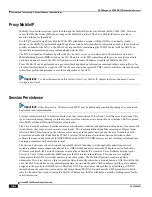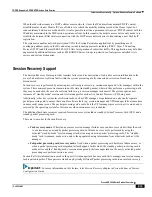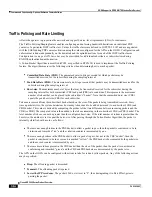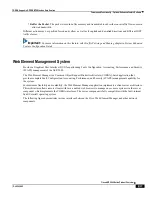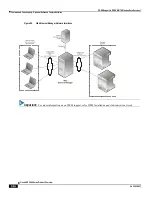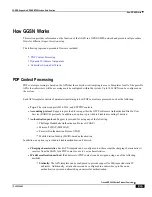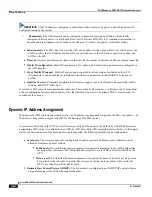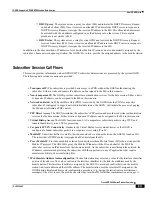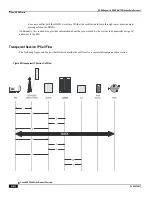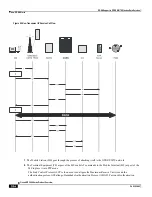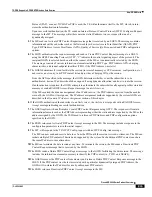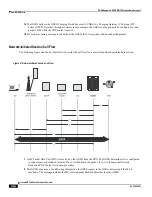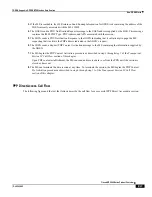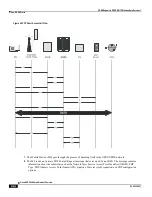
GGSN Support in GPRS/UMTS Wireless Data Services
Features and Functionality - Optional Enhanced Feature Software ▀
Cisco ASR 5000 Series Product Overview ▄
OL-22938-02
Multimedia Broadcast Multicast Services Support
Multimedia services are taking on an ever-increasing role in the wireless carriers' plans for an application centric service
model. As such, any next generation GGSN platform must be capable of supporting the requirements of multimedia
service delivery, including:
Higher bandwidth requirements of streaming audio and video delivery
Efficient broadcast and multicast mechanisms, to conserve resources in the RAN
MBMS represents the evolutionary approach to multicast and broadcast service delivery. MBMS uses spectrum
resources much more efficiently than Multicast-over-Unicast by optimizing packet replication across all critical
components in the bearer path. Thus, services requiring largely uni-directional multicast flows towards the UE are
particularly well suited to the MBMS approach. These would include news, event streaming, suitably
encoded/compressed cable/radio programs, video-on-demand, multi-chat / group-push-to-talk/video-conferencing
sessions with unicast uplink and multicast downlink connections, and other applications.
For MBMS functionality, the system supports the Gmb interface, which is used signal to the BM-SC
Important:
For more information on this feature, refer
Multicast Broadcast Service
chapter in
System Enhanced
Feature Configuration Guide
.
Overcharging Protection on Loss of Coverage
This solution provides the ability to configure mobile carriers to maximize their network solutions and balancing the
requirements to accurately bill their customer.
Considerin a scenario where a mobile is streaming or downloading very large files from external sources and the mobile
goes out of radio coverage. If this download is happening on Background/Interactive traffic class then the GGSN is
unaware of such loss of connectivity as SGSN does not perform the Update PDP Context procedure to set QoS to 0kbps
(this is done when traffic class is either Streaming or Conversational only). The GGSN continues to forward the
downlink packets to SGSN. In the loss of radio coverage, the SGSN will do paging request and find out that the mobile
is not responding; SGSN will then drops the packets. In such cases, the G-CDR will have increased counts but S-CDR
will not. This means that when operators charge the subscribers based on G-CDR the subscribers may be overcharged.
This feature is implemented to avoid the overcharging in such cases.
This implementation is based on Cisco-specific private extension to GTP messages and/or any co-relation of G-CDRs
and S-CDRs. It also does not modify any RANAP messages.
Important:
For more information on this feature, refer
Subscriber Overcharging Protection
chapter in
System
Enhanced Feature Configuration Guide
.
Summary of Contents for ASR 5000 Series
Page 1: ......
Page 26: ......
Page 48: ...New In Release 10 0 SCM Features Cisco ASR 5000 Series Product Overview OL 22938 02 ...
Page 50: ......
Page 58: ......
Page 68: ......
Page 126: ......
Page 138: ......
Page 146: ......
Page 218: ......
Page 236: ......
Page 356: ......
Page 374: ......
Page 422: ......
Page 496: ......
Page 572: ......
Page 654: ......
Page 700: ......
Page 726: ......
Page 784: ......
Page 816: ......
Page 844: ......
Page 906: ......
Page 926: ......
Page 942: ......
Page 943: ...Cisco ASR 5000 Series Product Overview OL 22938 02 Chapter 30 Technical Specifications ...
Page 966: ......
Page 972: ......

